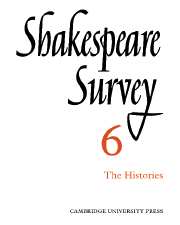Book contents
- Frontmatter
- Shakespeare's History plays: 1900-1951
- The Unity of 2 Henry IV
- Anticipation and Foreboding in Shakespeare’s Early Histories
- Middle-Class Attitudes in Shakespeare’s Histories
- A Reconsideration of Edward III
- On Producing Henry VI
- The Huntington Library
- An Early Elizabethan Playhouse
- Shakespeare Learns the Value of Money: The Dramatist at Work on Timon of Athens
- Shakespeare’s French Fruits
- An Elizabethan Eyewitness of Antony and Cleopatra?
- Othello’s “It is the cause . . .”: An Analysis
- On Translating Hamlet
- Shakespeare in China
- International Notes
- Shakespeare Productions in the United Kingdom: 1951
- Shakespeare’s History Plays - Epic or Drama?
- Festival Shakespeare in the West End
- The Year's Contributions to Shakespearian Study 1 Critical Studies
- 2 Shakespeare’s Life, Times and Stage
- 3 Textual Studies
- Books Received
- Index
- Plate Section
A Reconsideration of Edward III
Published online by Cambridge University Press: 28 March 2007
- Frontmatter
- Shakespeare's History plays: 1900-1951
- The Unity of 2 Henry IV
- Anticipation and Foreboding in Shakespeare’s Early Histories
- Middle-Class Attitudes in Shakespeare’s Histories
- A Reconsideration of Edward III
- On Producing Henry VI
- The Huntington Library
- An Early Elizabethan Playhouse
- Shakespeare Learns the Value of Money: The Dramatist at Work on Timon of Athens
- Shakespeare’s French Fruits
- An Elizabethan Eyewitness of Antony and Cleopatra?
- Othello’s “It is the cause . . .”: An Analysis
- On Translating Hamlet
- Shakespeare in China
- International Notes
- Shakespeare Productions in the United Kingdom: 1951
- Shakespeare’s History Plays - Epic or Drama?
- Festival Shakespeare in the West End
- The Year's Contributions to Shakespearian Study 1 Critical Studies
- 2 Shakespeare’s Life, Times and Stage
- 3 Textual Studies
- Books Received
- Index
- Plate Section
Summary
Since 1760, when Capell claimed that Edward III was written by Shakespeare, its authorship has been discussed by numerous critics. In the nineteenth century, Tennyson, Ward and Fleay believed that the Countess scenes were Shakespearian, while Swinburne, Saintsbury, Symonds and Moore Smith denied their authenticity. In the present century, Tucker Brooke, while admitting that these scenes were much more Shakespearian at first sight than the rest of the play, came to the conclusion that they were by the same author as the remaining scenes, and that this author was George Peele. F. W. Moorman argued that Shakespeare revised the play between 1590 and 1596, and that he completely rewrote the Countess scenes. R. M. Smith showed that Froissart provided the main source of the play, and that the Countess episode was derived from this source as well as from Painter’s Palace of Pleasure. Smith, however, went beyond the evidence when he concluded that the whole play must have been written “at one time by one playwright”, and that this playwright could not have been Shakespeare. At about the same time, Platt argued that as “Lilies that fester smell far worse than weeds” and “scarlet ornaments” were both more appropriate to their contexts in the Sonnets than to those in the play, the unknown author must have seen some of the sonnets in manuscript. Sir Edmund Chambers cautiously supported the view that Shakespeare wrote not only the Countess scenes, but also IV, iv. Finally, Alfred Hart, by means of vocabulary tests, came to the conclusion that the whole play must be either by Shakespeare or by some author unknown—not by Peele, Greene, or Marlowe.
- Type
- Chapter
- Information
- Shakespeare Survey , pp. 39 - 48Publisher: Cambridge University PressPrint publication year: 1953
- 1
- Cited by



